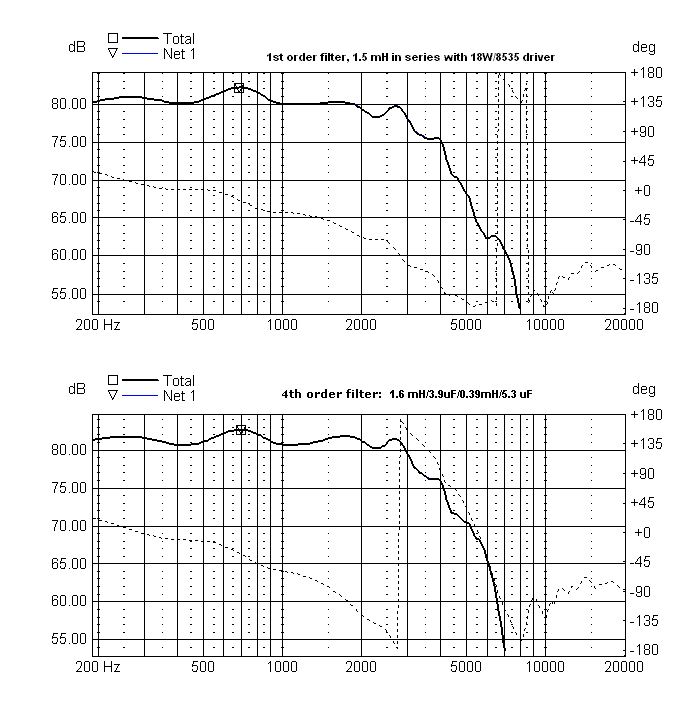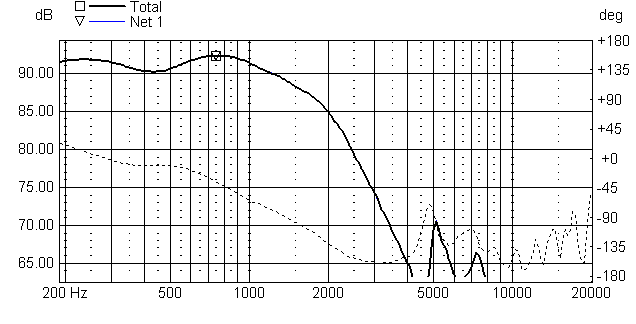FAQ regarding sensitivity
and the choice of crossovers.
If we want deep bass from
small loudspeakers, the price to be paid is efficiency.
Read below:
(2021: this is an old file and most links are no longer
working)
Q:
I was just having a question or comment on your xovers.
I notice that most of your xovers use higher order and
most of them have parallel components. I know
that one has to use Zobel network and notch filters
for the obvious purpose, but the more parallel components
a xover has, the less efficient the speaker will
be. I do believe that efficiency is important and
it sure helps improve sound transparency. I was reading
about an article with regard to the upgrade that was made
to the previous Living Voice speakers xovers in
which the Zobel network was removed to improve the bass
and transparency of the speaker. Anyway,
that is just my opinions on xover in general.
Thanks for your time.
Andy
A:
Thanks for your response to my website. I would
like to use your questions and comments as an
add to my website for a "discussion" on pros
and cons on simple vs. complex crossovers,
notch-filters, efficiency, etc.
I have no fixed preference for any type of crossover,
although I very seldom come across 1st order filters that
I can live with for an extended period of time. Very few
drivers manage the immense overlap properly - and the mix
of "sounds" - to my ears - colour most
instruments and vocals. Very few drivers have a
reasonably flat response - if combined with large
magnets/high sensitivity - unless mounted on infinite
baffles. And getting 95 dB sensitivity is usually at the
expense of anything below 50 Hz - unless we are talking
100 litre cabinets or more. A few e.g. Vifa drivers have
an intrinsic flat response, but due to small magnets
and/or highly damped suspensions, i.e. poor transient
response, etc. And the result is low sensitivity, e.g.
Vifa. P13WH.
The statement that high efficiency should improve
transparency is new to me. I can find a lot of very high
efficiency speakers that sound terrible, e.g. Cerwin
Vega.
Notch filters: 3-5 dB bumps in any (audible) frequency
domain is likely to throw a lot of details never heard
before, but was this what the performer and
recording engineer had in mind? Is this high-fidelity in
the strict sense of the word? Any deviation from a
"flat" response profile must be a
"distortion" of the original signal put into
the grooves - or dots. A lot of manufactures
"voice" their speakers to a specific sound
they feel - or know - will sell. Because they need
to sell, otherwise they're out of business.
With regard to the Living Voice upgrade, the improvement
in sound may be significant, but not necessarily because
the zobel network has been removed. What we don't know
from this tweak is how the frequency response, phase
tracking, etc. now looks compared to what it was before
the change. The zobel network will produce a linear
impedance profile of the driver but leaving out the zobel
network can be actively used in the construction of the
crossover. With drivers featuring symmetric drive, like
Scan-Speak, it's hardly necessary to ad zobel networks
due to an intrinsic linear impedance profile.
I don't think I have any constructions with zobel
networks. Not because I don't like them, but because they
were not necessary. If I did 1st order networks, I'd
probably use them from time to time.
Regards, Troels
Q:
The thought of sending you an email came up
when I was reading Kevin opinions of his TJL
speaker. The things that caught my attention was
his comments that the TJL seems to be inefficient (he had
to turn up the volume more than usual) and lacking in
dynamics, so I thought it might have to do with the
design of the xover. The xover of the TJL is 3rd
order. I also remember reading that the Thor from
Madison Sound which uses the same driver
http://www.madisound.com/index.html as
the TJL albeit in a D'Appolito configuration. The
xover of the Thor uses 1st order with only a series
inductor and a notch filter at 4.5khz. I don't mean
to compare the two speakers but I was wondering if you
had considered using 1st or 2nd order filter for the TJL?
Andy
A:
OK, so let's get this right before we proceed:
The impact on efficiency has nothing to do with the
choice of order of crossover. Check graph below: This is
a 18W/8535 driver applied a 1st order filter (top)
and (below) a 4th order filter to get
"flat" response in the 200-2000 Hz range. As
can be seen: same SPL level for both crossover
topologies. Actually the 4th order is 1 dB better than
the 1st order - because I made it that way.

The TJL has a sensitivity similar
to the 2.5 clone and is in line with most 6"+1"
speakers derived from this kind of philosophy, where we
want decent bass from a small bass driver, thus using a
driver with the appropriate TS-data to get the desired F3
of the construction. One problem here is that most
commercial constructions exaggerate the sensitivity of
their constructions - sometimes grossly.

Above
is the THOR crossover applied to the W18001 driver and
the magnesium cone break-ups are only 20 dB down in the
5-8 kHz range, and this will clearly have a negative
impact on tweeter performance.
There's a commercial element in any construction released
from a driver manufacturer, and this may be just about
good enough for most people not to be aware of the
intrinsic cone break-up, but we will never render the
full potential of these drivers with this simple
approach.
Read a good discussion on how "Phat" is
"Flat":http://www.speakerbuilder.net/web_files/Articles/phat/hpif.htm
Regards, Troels
Q:
About TJL Kevin comment:With loudspeaker with
high order filter, complex network. You should write,
more if the filter is complex, it's need an amplifier
with highest current capacity. The passive components (
capacity and inductor) need current to work fine. It's
very important the link between the amplifier and the
loudspeaker. It's depending of the number of drivers too.
With modern loudspeaker, you need current to have a good
sound:
I think about Thiel :
http://www.thielaudio.com/ see for
example :
http://thielaudio.com/THIEL_Site/Pages/models/Current_Models/cs6/cs6.html and ATC
:
http://www.atc.gb.net/
. If you
can, listen the passive close box SCM20, very heavy with
82dB sensitivity, the dealers don't like it ;-).
Their filter are complex and they need great amplifier
with high current output and good musicality. I think
it's a philosophy like we can find in high sensivity
system with horn and other ...SEAS with the magnesium
driver is a very good compromise.
Regards, Rodolphe
A:
I have a webpage planned regarding crossovers as it is a
common misunderstanding that complex crossover are
responsible for high current demands and low sensitivity.
This is no way the case. The efficiency of a
construction is dependant on the sensitivity of the
drivers and the current demand mostly dependant of this
and the bass-reflex tuning where the relation between
voltage and current may cause large amounts of power to
be drawn from the power amplifier. We can make a 2-way
speaker with 6 dB filters that draws high current and a
4th order filter with high sensitivity that is mild on
the amplifier. All depends on the drivers (impedance) and
the cabinet tuning. If you have a low impedance like 2
ohm (like the Watt/Puppy) and at the same time a
phase that is largely capacitive, then you will draw high
current.
Another problem here is that commercial speaker
manufacturers usually state 3 dB more sensitivity than is
real. The Response 2.5 is a good example, where ProAc
claim 86 dB and John Atkinson measures 83 dB - the same I
measure from the 2.5 clone.
Regards, Troels
Comments
from Sven, DK:
High efficiency drivers have less distortion due
to reduced current flow through the voice coil at a given
acoustic output, i.e. reduced magnetic un-linearity and
reduced voice coil temperature and rise in impedance.
A:
Good point!
I may modify the statement by saying that a high
efficiency driver may have reduced distortion;
that is if the driver is properly constructed. We can
find high-efficiency drivers (PA) that are quite
terrible. But let's leave out the poor examples and
assume we're dealing with well designed drivers.
And again, I'd love to only make speakers with a
sensitivity above 90 dB/W, but as stated before, if we
wan't deep bass from small cabinets, we have to sacrifice
efficiency.
More
comments are highly welcome and will be added to the
website.
|

